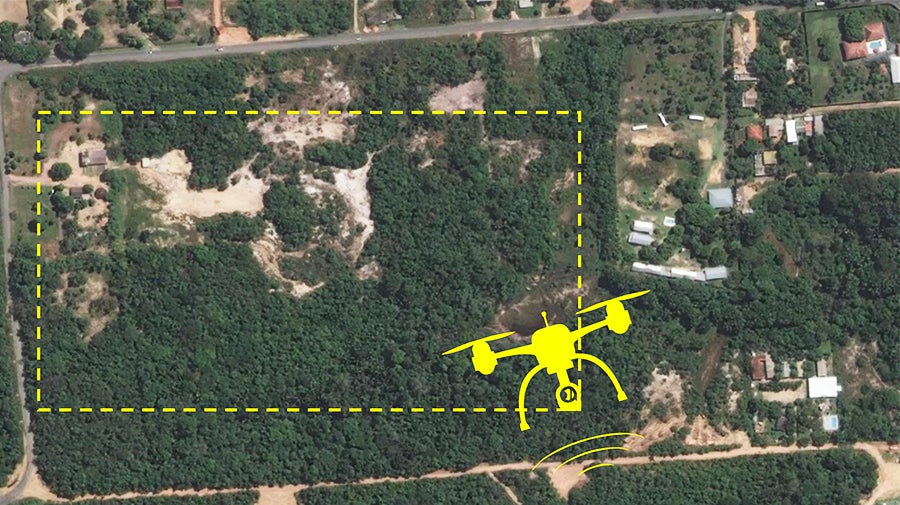Este artículo está también disponible en / This post is also available in: Spanish
Many cities in Latin America and the Caribbean (LAC) face the challenge of rapid informal urban growth, which prevents them from providing basic services to their citizens and have a sustainable urban development. Today, drones, artificial intelligence (AI) and machine learning (ML) provide key information for cities to better understand informal growth patterns and improve urban management. The pilot project with drones in Manaus of the Inter-American Development Bank (IDB), financed by the IDB’s Cities Lab, tested these tools to monitor the actual growth of informal occupation patterns; evaluate the possibility of using drones over other traditional methods; and demonstrate their potential for urban management.
The city of Manaus is located in the middle of the Amazon, the world’s largest rainforest and it’s the economic center of the northern region of Brazil. In the past decade, Manaus was one of the Brazilian municipalities whose population grew the most in absolute terms. From 2000 to 2010, the city’s population grew 2.51% annually, compared with 1.95% of the state and 1.18% of Brazil[1]. Today its population is estimated to be more than 2 million inhabitants.
The rapid population growth and the increase in land invasions made it difficult for the municipality to manage its territory, hindering the provision of basic services to citizens and increasing deforestation. Other consequences include the expansion of risk prone areas, pollution of water sources and interference with urban mobility.
As part of the continuous collaboration of the IDB’s Housing and Urban Development Division (HUD) to promote Manaus’s sustainable urban development, the Bank launched the pilot in collaboration with Manaus’s sub-Secretariat of Information Technology (SubTI) to test the use of drones to improve the monitoring efficiency of informal settlements growth patterns. The initial project included 50 flights, used AI and ML solutions, and trained municipal officials on the use of drones.
The idea of using drones to address informal occupation challenges derives from their flexibility and availability, which enables the municipality to capture the current situation of a designated area. In one of the pilot’s locations, suspected in informal activity, the drone’s aerial survey revealed a well-developed informal community that consisted of more than 60 housing units. Originally, the city had only two satellite images of this area, taken in 2010 and 2016, and didn’t have additional visual data to observe the new developments. The drones provided frequent and updated data that proved that the growth of informal occupation is rapid and should be monitored frequently.

Based on the objectives of the pilot, an aerial survey was carried out to monitor informal occupation patterns and evaluate the efficiency of using drones. The aerial survey included 3 areas of 15 hectares each, which were monitored weekly for 3 months to detect changes in land use. ML solutions, such as LATAM (Developed by the Argentinian based company Dymaxion Labs and offered through the IDB’s Code for Development initiative), were used to analyze the images and identify growth patterns of pre-selected area (view images below).

Although the difference is noticeable to the naked eye, it’s still difficult to quantify and measure it. However, the ML analysis showed that in the short period of five weeks there was an increase of 129% in informal construction in the field (from 85 to 195 roofs), which confirmed that informal occupation growth pattern occurred on a weekly and daily basis, and therefore required an adequate monitoring solution.

The AI and ML solution also revealed the relations between deforestation and new constructions patterns. When analyzing vegetation cover and deforestation patterns in the images above, the pilot showed a decrease of 27% in vegetation (from 18 to 13 acres). Moreover, the correlation between deforestation and the new housing constructions pattern demonstrates the potential of using ML and AI tools to anticipate urban growth based on deforestation patterns.

Housing is a primary need, but when done sporadically, without urban planning, it can be harmful to the environment and society at large. Therefore, drones are a vital tool to visualize, quantify and measure the scope of such activities and produce valuable and immediate data for better control. Additionally, technologies can better predict and help eradicate —or prevent— irregular activities that compromise urban planning. Finally, drones, AI, and ML solutions can serve municipalities, such as in the case for Manaus, to integrate informal dwellers into social programs of employment, income, and housing, and promote land upgrading, infrastructure mapping, tax planning, environmental monitoring, and others, which are essential features for sustainable urban development.
[1] IBGE, 2010


Leave a Reply